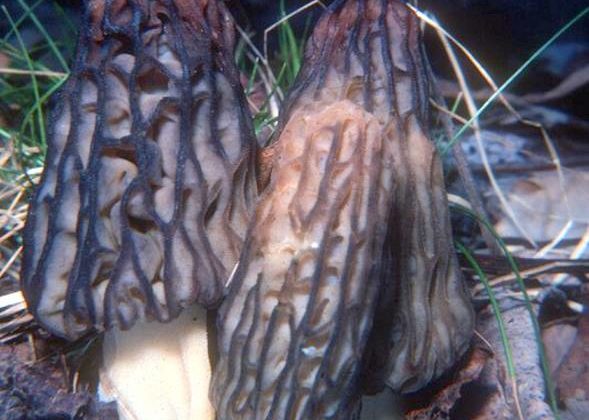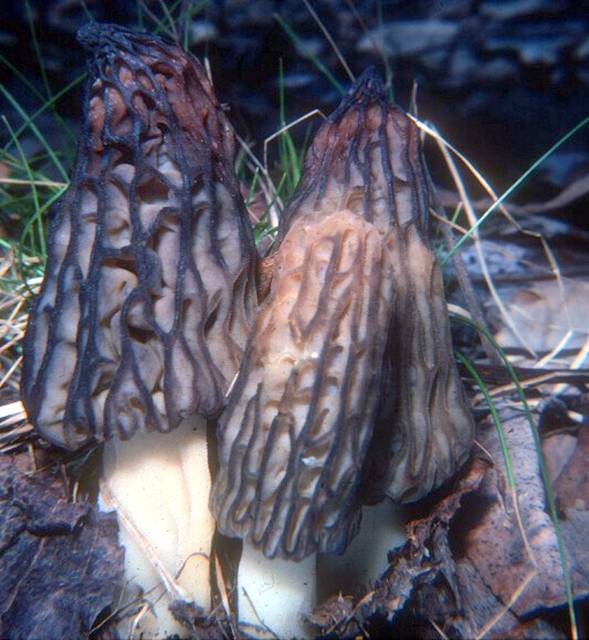
Wild mushrooms abound in Ohio
Story by Jane Beathard
Photos courtesy Walter Sturgeon

Spring in Ohio brings sunshine, warm rains and a certain breed of hunters into the woods.
These outdoor enthusiasts are not seeking whitetails or turkeys, but a sometimes more elusive prey — wild mushrooms.
Foraging for mushrooms is a cultural activity that often spans generations of a family. That’s the way it was for Central Ohio resident Ted Slanker.
Slanker’s parents were avid mushroom hunters and they passed that passion onto their son, who was about age 4 when he joined in their searches.
“We couldn’t wait to go,” he said. “It was a passage of spring.”
Slanker’s late wife, Anne, learned to share in her husband’s fun and joined his woodland adventures with gusto.
Slanker recounted a time when the two gathered a large bag of morels, then bartered them for steak dinners and a bottle of wine in a Springfield restaurant.
The chef was delighted to make the trade.
Eastern Ohio resident Walter Sturgeon is a nationally recognized authority on woodland fungi and the author of “Appalachian Mushrooms: A Field Guide.”
Sturgeon’s father first took him to the woods and fostered the boy’s interest in foraging for wild food. A 1975 Christmas present, the Whole Earth Catalogue, cemented that interest and led Sturgeon to the Ohio Mushroom Society.
“I could take a picture of a mushroom and get it identified (by them),” Sturgeon said.
Forty years later, his interest in field mycology — the study of fungi and their use to humans — has not dimmed. In fact, it has broadened to the study of environmental impacts on woodlands and forest health.
“Mushrooms get their strength from trees and vice-versa,” he said. “Without healthy trees, there are no mushrooms.”
He calls himself a “pseudo-scientist” and travels the country dispensing advice on mushroom hunting and feasting, as well as tips on woodland survivability.
He calls mushrooms “fruit” and compares harvesting them to “picking an apple off a tree.”
The Appalachian area is a hotbed of mushroom hunting activity with the biggest density growing in the Smoky Mountains, he said.
Many hard-core hunters travel hundreds of miles to search, sometimes starting in Georgia in February and moving north with the spring weather. Some participate in “forays” — gatherings that include mushroom hunting, as well as socializing and outdoor educational programs.
Michigan is a favorite goal of these adventurers. The state hosts several mushroom festivals annually.
A good number of mushrooms are quite edible, although they might be tough, woody and unappetizing. And while consuming some varieties will lead to illness, few are deadly to humans, Sturgeon said.
“Some are gourmet, and some are deadly,” he said.
The old saying that toadstools are poisonous and mushrooms safe is just a “wives’ tale.” Sturgeon says some toadstools are safe to eat and some mushrooms are poisonous. It really goes both ways.
Ohio has more than 2,000 documented varieties of mushrooms with many more undocumented.
Of those, the most sought-after mushroom is the “true” morel which has a distinctive honeycomb surface.
“False” morels have a roundish, wrinkled surface and are poisonous, Sturgeon cautioned.
True black morels are the first to appear annually — generally about the first week of April in Ohio when the ground warms to about 50 degrees. White and yellow morels soon follow. All are edible.
Searching for mushrooms in the wild takes both knowledge and skill. Sturgeon offers this advice to novice hunters:
• Use a field guide or take a knowledgeable friend along on the hunt.
• Check the rules before venturing onto public lands (state and national parks, wildlife areas, forests). Not all allow mushroom hunting.
• Never hunt on a golf course or where weed killer has been applied.
• Hunt early in the morning and within a week of a rainstorm.
• Hunt on south-facing hillsides.
• Hunt near old and dying elm trees where the bark is still peeling.
• Hunt near tulip trees or in fruit orchards — especially apple orchards.
• Look anyplace that has been burned where cinders are on the ground.
• Use any type of bag for gathering.
• Leave stems on while cutting dirt off.
• Wash harvested mushrooms, but don’t soak. Then, dry thoroughly.
• Cut mushrooms vertically and check for bugs.
• Never eat any wild-harvested mushroom raw. All must be cooked.
____
The Ohio Mushroom Society is looking for members in southwest Ohio. The society holds annual “forays” — meetings that include both hunts and educational programs. Check ohiomushroomsociety.wordpress.com for more information.
ID, 'source', true); $sourcelink = get_post_meta($post->ID, 'sourcelink', true); $sourcestring = '' . __('SOURCE','gabfire') . ''; if ($sourcelink != '') { echo "
$sourcestring: $source
"; } elseif ($source != '') { echo "$sourcestring: $source
"; } // Display pagination $args = array( 'before' => '' . __('Pages:','gabfire'), 'after' => '
', 'link_before' => '', 'link_after' => '', 'next_or_number' => 'number', 'nextpagelink' => __('Next page', 'gabfire'), 'previouspagelink' => __('Previous page', 'gabfire'), 'pagelink' => '%', 'echo' => 1 ); wp_link_pages($args); // Display edit post link to site admin edit_post_link(__('Edit','gabfire'),'','
'); // Post Widget gab_dynamic_sidebar('PostWidget'); ?>